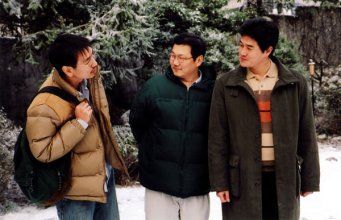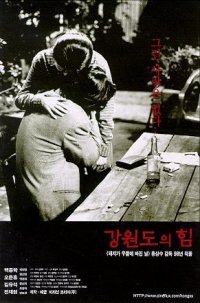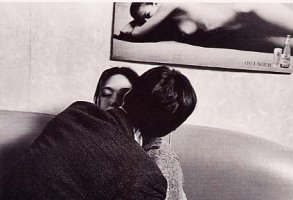This essay was originally published in a brochure produced on the occasion of the Wexner Center for the Artsí February 2006 Hong Sang-soo retrospective. © The Ohio State University/Wexner Center for the Arts. Reproduced by permission.
Delays In Celluloid
by Chris Stults
"Nine-tenths of our movements obey habit and automatism. It is anti-nature to subordinate them to will and thought."
- Robert Bresson, Notes on Cinematography
In the opening scene of Hong Sang-soo's fifth film, Woman Is the Future of Man, two estranged college friends are reunited, and the more successful of the two offers the other a gift: the chance to be the first to walk through the newly fallen snow covering his lawn. The friend then walks backwards through the snow a short distance before retracing his steps while walking forward.
 Generally the cinema of Hong Sang-soo is not given to symbolism or metaphor, but it is hard not to read this scene as a literalization of a frequent occurrence in his films. By doubling back on his tracks, the character joins a long line of Hong's protagonists who attempt to recreate or repeat earlier experiences in a different context (forward vs. backward movement) and, in doing so, they often end up exactly where they started despite the appearance of forward motion in the tracks they leave.
Generally the cinema of Hong Sang-soo is not given to symbolism or metaphor, but it is hard not to read this scene as a literalization of a frequent occurrence in his films. By doubling back on his tracks, the character joins a long line of Hong's protagonists who attempt to recreate or repeat earlier experiences in a different context (forward vs. backward movement) and, in doing so, they often end up exactly where they started despite the appearance of forward motion in the tracks they leave.
This description alone may make Hong's work sound similar to that of Wong Kar-wai, who is equally obsessive about vagaries of memory, routine, repetition and arrested progress. But the tone that each filmmaker adopts makes all the difference in the world -- Wong constructs romanticized dreams of stasis and longing; Hong's bracing portraits are anything but romantic. The protagonists of Hong's films are often the types of immature, indecisive men that have been the subjects of countless films. But rather than editorialize and present idealized versions of these characters as most filmmakers have, Hong provides nonjudgmental but incisive observations that produce an uncomfortable, often painful (and sometimes painfully funny), sense of their booze-fueled maladroitness.
Conventional wisdom would paint Wong Kar-wai as a stylist and Hong Sang-soo as a naturalistic filmmaker. However, despite their matter-of-fact cinematography Hong's films are as far removed from realism as Wong's are, and his style is as every bit as distinct and definable. In all likelihood, no one working today thinks as consistently and complexly about form in narrative film as Hong does. As he has said, "People tell me I make films about reality. They're wrong. I make films based on structures that I have thought up." (1)
 Save Woman Is the Future of Man, his experiment in linear storytelling (with a few digressions), Hong's films have thoroughly mined the possibilities of multiple points of view (The Day a Pig Fell Into the Well), bifurcated narratives (The Power of Kangwon Province, Turning Gate, Tale of Cinema), or both (Virgin Stripped Bare by Her Bachelors). Although Hong often returns to the same structures, he has done so for a different purpose in each instance. The result is a dense, rich body of work where each film builds on (and sometimes responds to) ideas from the previous one. Each of Hong's films holds up in isolation, but the similarities and differences between them become more pronounced and more profound when viewed in toto.
Save Woman Is the Future of Man, his experiment in linear storytelling (with a few digressions), Hong's films have thoroughly mined the possibilities of multiple points of view (The Day a Pig Fell Into the Well), bifurcated narratives (The Power of Kangwon Province, Turning Gate, Tale of Cinema), or both (Virgin Stripped Bare by Her Bachelors). Although Hong often returns to the same structures, he has done so for a different purpose in each instance. The result is a dense, rich body of work where each film builds on (and sometimes responds to) ideas from the previous one. Each of Hong's films holds up in isolation, but the similarities and differences between them become more pronounced and more profound when viewed in toto.
Beyond their global structures, the forms of Hong's films are worth examining on a moment-to-moment level (and often need to be so examined in order for a viewer to understand the film). There is a lack (or uniformity) of emphasis in Hong's scenes that makes different demands on the audience and requires another sort of attention than most films do. Many scenes serve a vague narrative function, or none at all; only in retrospect, after the accumulation of a number of details (or even after the conclusion of the film), does their importance become clear. Seemingly "throwaway" sequences that would play as "dead," transitional, or establishing scenes in traditional films can contain details crucial to the film's meaning. In The Power of Kangwon Province, an establishing shot of a character turns out to reveal a link between the film's two halves. In Tale of Cinema a shift in the film's reality is signaled only by a music cue. Hong displays a bold level of trust in the viewer and gives them an extraordinary amount of responsibility in assembling meaning, but audience members who are able to meet his demands are rewarded in ways conventional filmmaking cannot provide. For viewers sensitive to them, Hong's films have the capability to achieve some of art's highest functions: to change the way we see ourselves, the world around us, and art itself.
One gets the sense that at heart Hong Sang-soo is a modernist living in post-modernist times, that he is using modernist techniques to describe postmodernist characters. As a friend observed, "Hong emphasizes nothing, even though it all counts." (2) Everything is connected although nothing means anything in isolation. The rudderless worldview of the characters may dominate the film in the present tense, but afterward Hong's guiding structure gives a previously unseen meaning to the events. That meaning may even lie within the grasp of Hong's characters -- although they would be the last to realize it.
 The characters (and most critics) also seem unaware of the strain of mysterious absurdity that subtly runs throughout Hong's films. Strange events and irreconcilable coincidences that wouldn't be out of place in a Buñuel film are presented as flatly as any other event in Hong's universe. As much as Hong's films do eventually tie together, there are still many beautifully mysterious moments that can't be explained away. The unusual titles are often elements that have a tenuous connection to the body of the narrative. A few titles are quite obvious in meaning (The Power of Kangwon Province, Tale of Cinema) but most, even after hearing their origin, remain unknowable except on an intuitive level. Hong's pig-less, well-less debut film, The Day a Pig Fell Into the Well -- for which Hong assigned a different writer to each of the four main characters (and is the only one of his films to date
that he did not write alone) -- takes its title from a seemingly unrelated John Cheever short
story. Woman Is the Future of Man is a line from a poem by French Surrealist Louis
Aragon -- while the title makes conceptual sense, it runs contrary to the action of the film, where woman is the past of man. The full English-language title of the film usually referred to as Turning Gate is On the Occasion of Remembering the Turning Gate (3), a quite literal title but nicely allusive to the type of comedy of manners that the film often recalls. Although Hong maintains that the English title Virgin Stripped Bare by Her Bachelors was picked solely for the phrase itself rather than as a reference to Marcel Duchamp's enigmatic artwork The Bride Stripped Bare by Her Bachelors, Even, there are parallels between the two works that are too rich to ignore.(4) The most notable is, perhaps, that Duchamp called his work a "delay in glass" and Hong's film, with its detours into memory and retardation of narrative, could be called a "delay in celluloid." Also, like Duchamp's The Large Glass, Hong's film is divided into two halves, one of which could reasonable be called the domain of the virgin and the other of the bachelor machine -- each separated by an "infrathin" layer of subjective ambiguity.
The characters (and most critics) also seem unaware of the strain of mysterious absurdity that subtly runs throughout Hong's films. Strange events and irreconcilable coincidences that wouldn't be out of place in a Buñuel film are presented as flatly as any other event in Hong's universe. As much as Hong's films do eventually tie together, there are still many beautifully mysterious moments that can't be explained away. The unusual titles are often elements that have a tenuous connection to the body of the narrative. A few titles are quite obvious in meaning (The Power of Kangwon Province, Tale of Cinema) but most, even after hearing their origin, remain unknowable except on an intuitive level. Hong's pig-less, well-less debut film, The Day a Pig Fell Into the Well -- for which Hong assigned a different writer to each of the four main characters (and is the only one of his films to date
that he did not write alone) -- takes its title from a seemingly unrelated John Cheever short
story. Woman Is the Future of Man is a line from a poem by French Surrealist Louis
Aragon -- while the title makes conceptual sense, it runs contrary to the action of the film, where woman is the past of man. The full English-language title of the film usually referred to as Turning Gate is On the Occasion of Remembering the Turning Gate (3), a quite literal title but nicely allusive to the type of comedy of manners that the film often recalls. Although Hong maintains that the English title Virgin Stripped Bare by Her Bachelors was picked solely for the phrase itself rather than as a reference to Marcel Duchamp's enigmatic artwork The Bride Stripped Bare by Her Bachelors, Even, there are parallels between the two works that are too rich to ignore.(4) The most notable is, perhaps, that Duchamp called his work a "delay in glass" and Hong's film, with its detours into memory and retardation of narrative, could be called a "delay in celluloid." Also, like Duchamp's The Large Glass, Hong's film is divided into two halves, one of which could reasonable be called the domain of the virgin and the other of the bachelor machine -- each separated by an "infrathin" layer of subjective ambiguity.
 The title of Tale of Cinema, like the surface simplicity of the film itself, hides the fact that this is one of Hong's most radical and complex films to date. Anyone familiar with Hong's earlier films will immediately notice the film's expanded cinematic vocabulary. Zooms and voiceovers appear in Hong's work for the first time. Lots of them. As the film progresses, it's not entirely surprising to encounter these devices in the first half of the film (the domain of art) but when they carry over into the second half (the domain of life), something new is going on. An entire essay could be written on the unusual ends to which Hong uses the zoom lens.(5) So, I'll restrict my comments to the arresting use of voiceover in the film's final scene, perhaps the most powerful in Hong's career. Despite the comparative preponderance of voiceover in the first half of the film, the closing scene of Tale of Cinema marks Hong's first use of nondiegetic voiceover. It's not just for this reason that the voiceover seems to exist outside of the film itself, almost as a memo to the main character rather than as the character's actual thoughts. Is this the moment to which Hong's first six films have been building? The moment when modernist Hong inserts himself into his narratives to show his characters the way out of the post-modernist condition?
The title of Tale of Cinema, like the surface simplicity of the film itself, hides the fact that this is one of Hong's most radical and complex films to date. Anyone familiar with Hong's earlier films will immediately notice the film's expanded cinematic vocabulary. Zooms and voiceovers appear in Hong's work for the first time. Lots of them. As the film progresses, it's not entirely surprising to encounter these devices in the first half of the film (the domain of art) but when they carry over into the second half (the domain of life), something new is going on. An entire essay could be written on the unusual ends to which Hong uses the zoom lens.(5) So, I'll restrict my comments to the arresting use of voiceover in the film's final scene, perhaps the most powerful in Hong's career. Despite the comparative preponderance of voiceover in the first half of the film, the closing scene of Tale of Cinema marks Hong's first use of nondiegetic voiceover. It's not just for this reason that the voiceover seems to exist outside of the film itself, almost as a memo to the main character rather than as the character's actual thoughts. Is this the moment to which Hong's first six films have been building? The moment when modernist Hong inserts himself into his narratives to show his characters the way out of the post-modernist condition?
1. Hong Sang-soo quoted in the press kit for Woman Is the Future of Man.
2. E-mail from Charles B. François dated November 29, 2004.
3. The film's original Korean title could be translated as Discovery of Living, an atypical instance of a title editorializing about the contents of the film.
4. The film was originally called Oh, Soojung! in Korea. Hong discussed his title and Duchamp's in a conversation with the author on October 2, 2005.
5. See Michael Sicinski's insightful essay on the film in issue 25 of Cinema Scope.
Chris Stults is assistant curator in the film/video program at the Wexner Center for the Arts. He has organized programs devoted to New Korean Cinema, Hong Sang-soo, Morgan Fisher, Lewis Klahr, Jennifer Todd Reeves, and Apichatpong Weerasethkul, among others.